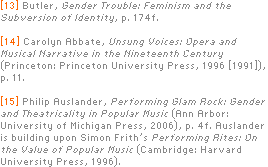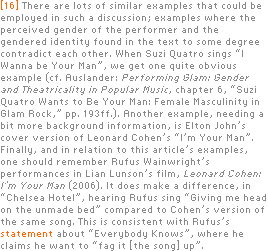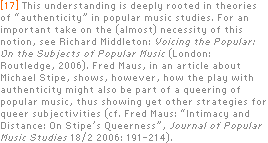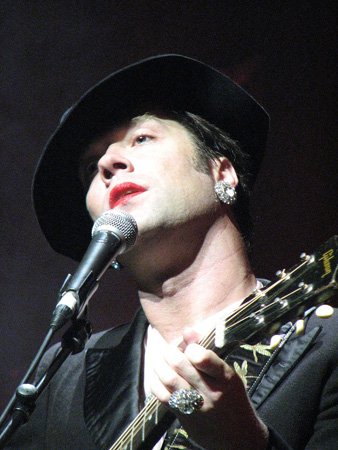| If this is discussed by way of theories of performance and performativity, and if this “person/a” is understood as a copy, then this is a copy without an original.[13] There are, as already mentioned, differentiations within the repetitions. Different vocal levels within musical performances have been underlined within opera-studies and popular music studies for quite some time. They make it possible for us to hear several voices so to speak in the “same” voice; it is not necessarily the case that it is the performer’s own voice (whatever that is) that we are hearing.[14] Dividing up different layers heard in a musical performance might throw some light on this. In his book Performing Glam Rock, Philip Auslander distinguishes three such layers: “the real person”, “the performance persona”, and “the character”.[15] These layers of course interact (and co-exist), and any division between them is thus highly heuristic. This heuristic dimension, however, might also cover up for the play of ambivalence at stake in such performances; it tends to “normalize” the ambivalent subject position, making it in one particular sense “straight”. The queer positions I am after in this article might, as my examples hopefully will show, complicate this whole picture, making it necessary to introduce either more “personas” or combining the different layers in other ways. “The Art Teacher” is sung from a pretty straightforward female position. Wainwright sings in the persona of a woman, where the song, in particular as captured in the text, is about her schooldays and her art teacher: |  | 

| 
|  |  | There I was in uniform
Looking at the art teacher
I was just a girl then;
Never have I loved since then He was not that much older than I was
He had taken our class to the Metropolitan Museum
He asked us what our favorite work of art was,
But never could I tell it was him
Oh, I wish I could tell him –
Oh, I wish I could have told him I looked at the Rubens and Rembrandts
I liked the John Singer Sargents
He told me he liked Turner
Never have I turned since then
No, never have I turned to any other man All this having been said,
I married an executive company head
All this having been done, a Turner – I own one
Here I am in this uniformish, pant-suit sort of thing
Thinking of the art teacher
I was just a girl then;
Never have I loved since then
No, never have I loved any other men |  | | 
|  |  | The text is from the female point of view, from her subject-position, whereas the voice we hear is a male voice. In other words, there is an ambivalence between the two levels. It is, however, heard as a man singing from a female’s point of view, and thus the ambivalence is relatively easily handled. But still, even with the ambivalence taken care of, it is still a challenge to any thought of an easy division of sexual difference.[16] Antony’s “For Today I Am A Boy”, on the other hand, is sung from a much more ambivalent position.
One day I’ll grow up, I’ll be a beautiful woman
One day I’ll grow up, I’ll be a beautiful girl
But for today I am a child, for today I am a boy
For today I am a child, for today I am a boy. One day I’ll grow up, I’ll feel the power in me
One day I’ll grow up, of this I’m sure
One day I’ll grow up, I’ll know a womb within me
One day I’ll grow up, feel it full and pure
But for today I am a child, for today I am a boy
For today I am a child, for today I am a boy.
Here we find possibilities of transgression or transformation; a possibility of change or movement between ascribed gender-identities. When the “I” – that is to say, the singer’s persona – grow up, s/he will be a woman. But for today s/he is a boy. The text points towards a potential crossing-over; the possibility of changing or moving between ascribed identities. But even in addition to the lyrics, the voice challenges. The “ethereal”, “angelic” voice of Antony, with the implicit difficulties of a clear-cut gendered identity, in short, the transgendered voice of Antony, contributes to the ambivalence heard, complicating the script. |  | 
| 
|  |  | It is not as if we hear any “core” subjectivity in these voices; we hear a voice performing and we hear different kinds of subject-formations. Given the tendency to ascribe some kind of agency to the artist and/or singer – a thought that they sing “about” themselves – the performing dimension opens up a field of negotiation for the interpretation of this music.[17] The same is at stake when interpreting poetry; do we hear the poet’s own self in the poems? In this context we should remember the difference between a poem and a song; listening to a song, we hear much more than the text. Perhaps the text is even the least interesting dimension. This, however, opens up for yet another layer: in addition to listening to the (presupposed) subjectivity of the artist, and to the subjectivity of the lyrics, we also listen to the subjectivity of the voice. These layers exist simultaneously, but the way we understand them, there is still a tendency to understand the voice as more intimately related to the subjectivity. The voice is so to speak our inner coming out; it resembles the “soul” as something existing in the body, with the possibility of “coming out”. |  | 
| 
|  |  | 
|  | | 
|  |  | 
|  |  | 
|  |  | When Rufus sings “I was just a girl then” he quite obviously, on the level of lyrics, challenges any straightforward identification between the singer and the text. Here we find a parallel to Judith Halberstam’s discussion, in Female Masculinity, of the “bathroom problem”.[18] This “problem” is related to divisions of gender in the case of public toilets, and Halberstam discusses how persons belong to one or the other. And this belonging is dependent upon looks; any surveillance of people will here take the visual as marker for which toilet a person belongs in. And as Halberstam exemplifies, when speaking the “gender-ambivalent” person will “prove” her or his belonging, the voice seemingly giving away the “correct” gender. But with song, we find another take on this. There seems to exist a parallel “voice problem”, in the sense that we have a tendency to ascribe gender to voices without much problem. We have male voices and female voices. But as Rufus demonstrates, the question is never that simple. As the “naturalness” of gender and/or sex has been questioned, so has the “naturalness” of the vocal register, as well as the supposed “genderedness” of the voice. And one of the things happening in “The Art Teacher” is that a presumed man sings from a woman’s point of view and from her subject-position and her experience, thus opening up for another way of listening both to the voice and to the subjectivity found “inside” it. So where Antony sings “for today I am a boy,” Rufus almost sings “yesterday I was a girl”. And Antony of course adds something to the effect of “tomorrow I’ll be a woman.” There is, then, a movement suggesting that the subject-position is something changing, being not identical with itself, but a field of negotiation, a field where different emotions, different experiences, are forever negotiated. And, in the wish – the wish for difference, the strive towards something else – these movements and potentialities are found. As when Antony wishes to become a beautiful woman, or when Rufus wishes s/he could tell him, could have told him. |  | 
| 
|  |  | 
|  |  |
|